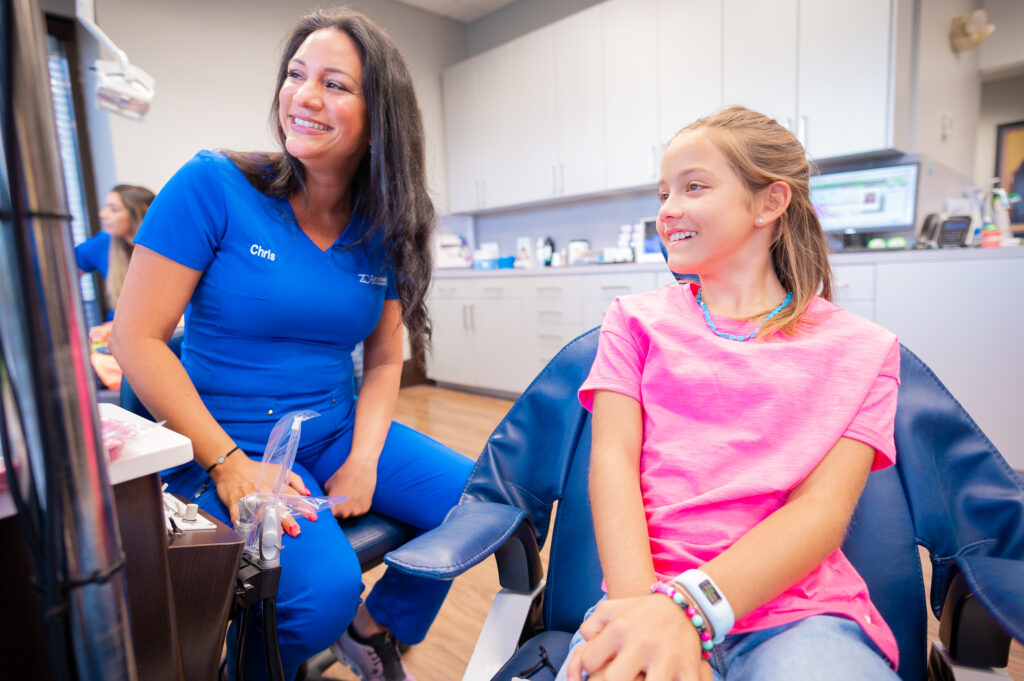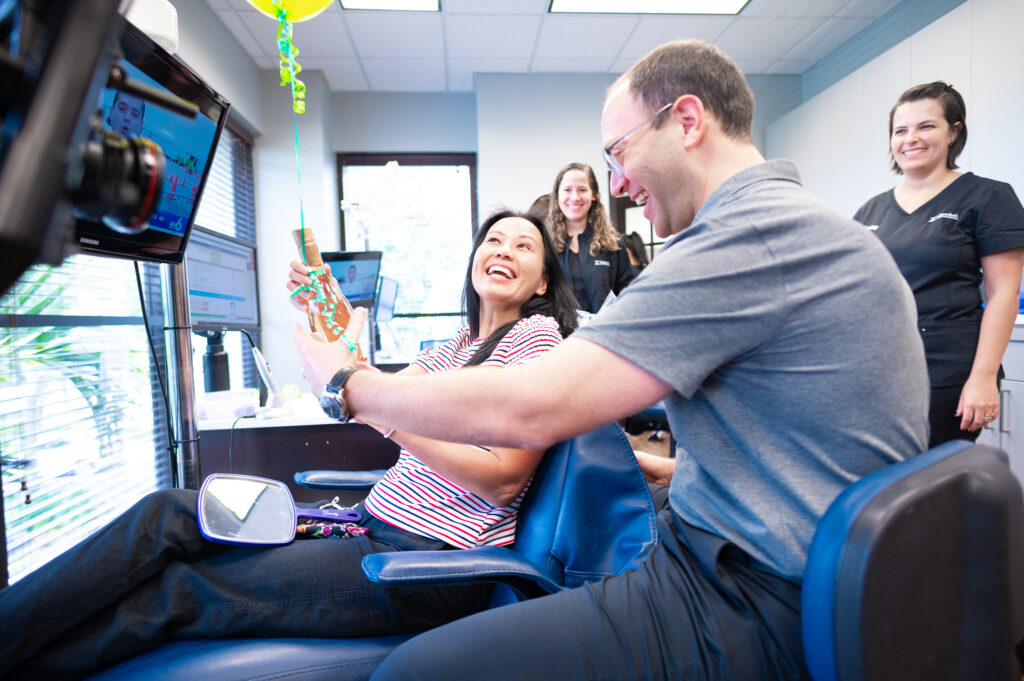Teeth! We all use them, but most don’t know much about them. Why do we have so many teeth?
Why do we get baby teeth first instead of adult teeth right away? How do human teeth stack up against other animal teeth?
Learning about teeth anatomy helps us understand how teeth help animals (and people) stay safe and strong. It can also help us appreciate why keeping our teeth straight and healthy is essential.
While your teeth are similar to your bones, they are different.
Bones have a thick outer layer with a soft inner layer called marrow. Teeth also have an outer shell with a soft interior but not marrow. Teeth consist of three main layers: enamel, dentin, and pulp.
The tooth enamel is the hard outer shell that protects your tooth. The dentin is the part of the tooth that protects the pulp and gives your enamel a good foundation. The pulp is the living tissue where you’ll find nerves and blood vessels of the tooth.
That means your teeth are living, and you must practice good oral hygiene to keep them healthy. Tooth decay, gum disease, and infection can weaken and eventually kill a tooth. That’s why at Zombek Orthodontics, we talk with you about the importance of brushing and flossing regularly!

Humans have four main types of teeth: Incisors, Canines, Premolars (bicuspid teeth), and Molars. Let’s look at the differences.
Your lateral and central incisors are the teeth located at the front of your mouth. You have four on top and four on the bottom. The incisors bite and chop food, like when you bite into an apple or corn on the cob.
The long, pointy teeth on either side of your incisors are the canines. Humans have four canines — two on top and two on the bottom. Canine teeth tear food, including meat.
We get premolars for the first time when we get our permanent teeth (babies don’t have premolars.) We have eight premolar teeth as adults.
There are two premolars located on each side, on top and bottom. The premolars sit behind the canines and help grind the food pulled apart by the canines and incisors.
The molar teeth are your big back teeth. They grind your food until it’s broken down enough to swallow. How many molars do you have?
Most adults have 12 permanent molars, three on each side, top and bottom, if they have all their wisdom teeth.
Wisdom teeth are the common name for the third molars that come in once we reach adulthood. Most people have four wisdom teeth, but not all! The Dental Research Journal reports that up to 37% of the population is missing wisdom teeth! Do you have all of yours?
It’s OK if you don’t have all of your wisdom teeth. The molars you do have are 100% up to the task.

You may think all teeth look and work alike in animals, but that’s not true! Carnivores, herbivores, and omnivores have very different teeth. Why? It’s all about diet!
Carnivores, like wolves, otters, tigers, and bears, eat only meat. They have sharp teeth throughout their mouths. Usually, meat eaters have lots of space between their teeth to keep debris from getting trapped there. Raw meat contains many dangerous bacteria that could quickly rot their teeth, a serious threat to survival in the wild.
Each type of tooth helps the carnivore in a unique and important way. Carnivores’ front teeth, their incisors, are pointed to help them catch and tear into their prey.
Carnivores’ large canine teeth help them fight their prey and each other and tear and shred meat from bones.
A carnivore’s molars are like knives, chopping their food into pieces small enough to swallow. Because carnivores have extremely acidic stomachs, they can quickly swallow large chunks of protein without bothering to chew.
Most of us expect that the big difference between carnivores’ teeth and omnivore teeth will be their canines. After all, why would animals like giraffes, hippos, and rabbits, which eat only plants, need teeth that tear meat?
Turns out many herbivores have canines. They have canines on the bottom, while carnivores usually have them on the top, too. It turns out that herbivores need a few sharp teeth.
While most herbivores need some sharp teeth, they don’t need the pointy front teeth (called incisors) that carnivores do. Instead, their incisors are chisel-shaped, which helps herbivores gnaw through hard seeds, woody plant stems, and tough grasses.
Many herbivores have a large space between their incisors and the rest of their teeth, called a diastema. Herbivores use this space as a sorting area. Their tongues find the inedible or thorny pieces and spit them back out, which protects the rest of the mouth.
Herbivores also use this space to reposition their food over and over again while they chew. Herbivores use their broad, flat molars to crush and grind their food into a paste. This allows for easy swallowing and digesting in the stomach and intestines.
Omnivores have a mixed diet. They eat both meat and plants. They need versatile teeth to take advantage of all kinds of food sources.
Omnivores’ incisors are sharp at the tip but wide, not pointy like carnivores’. This wide, sharp edge lets omnivores slice off chunks of meat, and it cuts plant material like a knife.
Omnivores’ molars can multi-task too. They’re wide like an herbivore’s molars so that they can grind up food. But unlike herbivores’ molars, their surface has multiple sharp points. Grinding and chopping help omnivores crush their food relatively quickly.
Quick eating is important for any predator, but unlike carnivores, omnivores can’t effectively digest meat unless it’s well-chewed.
Like herbivores and carnivores, many omnivores have long, sharp canines. These help omnivores catch prey, compete for dominance, and defend themselves, their territory, and their young against predators.
Humans make many different choices about what we do and don’t eat. Our teeth make it possible for us to eat an omnivore’s diet or any diet.

The short answer to this question is that we grow! Babies’ small heads make birth possible, but by age 1, our heads are already about 87% of their adult size. Baby teeth, also called primary teeth, deciduous teeth, and milk teeth, help us develop as we grow.
Baby teeth start appearing around six months of age. They help us develop important skills like speaking and eating while our heads and jaws grow.
How many teeth do kids have? 20! They have eight incisors, four canines, and eight molars.
Permanent teeth replace those and add eight premolars and four wisdom teeth. A total of 32 permanent teeth!
Permanent teeth are developing in our jaws even as our baby teeth are first erupting from our gums. Eventually, children need bigger teeth to eat properly, so baby teeth fall out.
Do baby teeth have roots? Yes, they do. But those roots dissolve, allowing the baby tooth to fall out and the permanent tooth to take its place.
By the time we’re teenagers, most permanent teeth are in, except for a few back molars. Wisdom teeth come in between ages 17 and 24, if at all.

Adult teeth should last a lifetime. But it’s natural for teeth to wear down, shift, or discolor slightly over time. Healthy teeth are essential to the survival of lions and squirrels, and they’re necessary for you, too! Throughout your life, your adult teeth help you to chew properly and speak clearly.
Your teeth wear down more quickly with misaligned teeth. A bad bite also increases your chances of gum disease, tooth decay, and even tooth loss. Orthodontic treatment realigns your teeth, making them easier to clean and more likely to last for the rest of your life.
Zombek Orthodontics is here to help you keep your smile healthy and strong for a lifetime. We offer braces treatment and Invisalign clear aligners to straighten your teeth.
Start with a virtual consult or schedule an appointment in the Weston, FL, or Hollywood, FL, areas. See how we can keep your smile beautiful and your teeth healthy!

 This site’s strategy, design, photo & video were created by the marginally-above-average folks @ Clear Partnering Group.
This site’s strategy, design, photo & video were created by the marginally-above-average folks @ Clear Partnering Group.